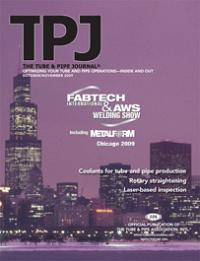- FMA
- The Fabricator
- FABTECH
- Canadian Metalworking
Categories
- Additive Manufacturing
- Aluminum Welding
- Arc Welding
- Assembly and Joining
- Automation and Robotics
- Bending and Forming
- Consumables
- Cutting and Weld Prep
- Electric Vehicles
- En Español
- Finishing
- Hydroforming
- Laser Cutting
- Laser Welding
- Machining
- Manufacturing Software
- Materials Handling
- Metals/Materials
- Oxyfuel Cutting
- Plasma Cutting
- Power Tools
- Punching and Other Holemaking
- Roll Forming
- Safety
- Sawing
- Shearing
- Shop Management
- Testing and Measuring
- Tube and Pipe Fabrication
- Tube and Pipe Production
- Waterjet Cutting
Industry Directory
Webcasts
Podcasts
FAB 40
Advertise
Subscribe
Account Login
Search
Shopping for a new tube mill coolant?
It takes more than comparing price tags
- September 2, 2009
- Article
- Tube and Pipe Production
Warren Buffett is known to have said, "Price is what you pay. Value is what you get." While the concept of price is straightforward, measuring value is tricky. In comparing two products, understanding what you get is much more complex than comparing the prices.
The current economic turmoil has caused many companies to attempt to reduce costs aggressively, and many have focused on prices of the products they use. Tube mill coolants are often viewed as simple line items that fall into the same category as hydraulic and engine oils, but the reality is that they are complex mixtures with multiple functions, many of which are critical to controlling operating costs and ensuring product quality.
Price per Gallon
The easiest cost metric to comprehend is price per gallon. It's a simple dollar figure which is written clearly on the invoice but doesn't represent the value of the coolant. It is not a large jump to extend this concept to one that is more useful: the cost of the diluted fluid, or the fluid in the concentration at which it is actually used.
This figure is found by multiplying the price of the product (in its concentrated form) by the operating concentration (as it is used in the system). A product used at a concentration of 5 percent instead of 6 percent reduces product usage by approximately 17 percent because the leaner dilution reduces the amount of material used to cool and lubricate the tubing.
Be aware that such a savings isn't simply a matter of turning a knob on the mixing unit. It's necessary first to confirm the fluid's designed operating range and the condition of the fluid in the system. It's also important to consider how this will affect rust formation. Among the factors that cause rust to form on the equipment and the tubing, the only one more critical than operating concentration is the product formulation. Maintaining a rust-free system is important because once rust has formed, it greatly increases the potential for future rust problems because suspended rust particles can seed rust onto freshly formed surfaces.
In addition to the operating concentration, fluid chemistry also affects product consumption. Emulsions such as soluble oils and semisynthetics form thicker films than true-solution synthetics. As a result, using synthetics can reduce coolant consumption, and for this reason they are preferred in modern high-speed mills. In the past synthetics were frowned upon because of problems associated with lack of lubricity, elastomer incompatibility, operator skin irritation, and their tendency to form gummy residues. Modern synthetics can reduce consumption but don't cause the problems associated with older technologies.
Extended Service Life
Every time a system is recharged, many costs are incurred, including the price of the new coolant, disposal of the old coolant, labor for cleaning, and downtime. The selection of a quality fluid, coupled with knowledgeable support, can reduce the recharge frequency and extend service life.
How does fluid chemistry affect service life? Three layers of chemistry are involved. First, the coolant should be formulated with bioresistant materials and combined with effective biocides and fungicides to prevent microbial growth, which can introduce rust-causing acids, deplete additives, and clog lines with biomass. Redundant buffering and corrosion inhibitors form the second level of protection, supporting the fluid's basic structure. The third and final layer of chemistry is raw materials that do not form residues, efficiently handle dirt particles, and are not easily depleted over time. Reducing dirt load, which reduces the number of colonization sites for microbes, takes a great deal of stress off the first two layers, thus extending their capability.
Consistent Performance
More important than merely surviving an extended service interval is the need for consistent performance over the entire period. Similar to a car as it ages, a fluid can reach a point at which the cost of maintaining or reviving it becomes more expensive than replacing it. Just as a poorly constructed car tends to require more repair costs over its lifetime, a poorly formulated fluid will require more intense monitoring and more frequent additions of pH boosters, alkalinity boosters, corrosion preventives, and biocides. All these activities can distract from the primary task of forming tube, increase the risk of rust, and lead to a costly unplanned dump and recharge.
In one actual example, a tube production facility switched from a low-priced coolant to another product and eliminated 50 drums of biocide annually. The savings actually exceeded the entire annual coolant budget.
Sludge Buildup
A fluid loses its ability to cool and protect against rust during its service life, but decreased cooling and rust protection capacities aren't the only reasons to dump it or add chemicals to revive it. Sludge buildup associated with the use of low-quality fluids is also a factor. Effective lubrication between the rolls and tubing reduces scaling and improves surface quality in addition to extending roll life. It also reduces the generation of microscopic metal fines that accumulate in the system and are glued together by coolant residues. Thus, a fluid that reduces both the creation of metal particles and insoluble residues will keep a system cleaner and reduce the need for desludging.
The following example illustrates the significance that a change in chemistry can have on the system's cleanness: A company that typically rented a backhoe to desludge its system switched to another product and later found that it generated less than a gallon of debris over the course of the previous preventive maintenance schedule. The change reduced cleaning time and production downtime.
Plant Maintenance
The value of a quality coolant goes farther still beyond drag-out rate, bioresistance, minimizing additive use, and easing fluid management. Coolants also affect other areas of maintenance around the plant. The most significant of these is the tooling's bearing life. The coolant and bearing grease are in intimate contact, so selecting compatible chemistries can extend the service life of both of them (see Figure 1).
This selection can be tricky because few grease manufacturers are also knowledgeable about tube mill coolants. However, careful research in comparing these combinations can lead to significant rewards. One tube producer, after selecting compatible chemistries, found that the money saved from not having to replace the bearings during the following year offset the cost of disposing the fluid, cleaning the system, and recharging its coolant system.
Tips for Coolant Selection
- Analyze the operating costs in addition to the purchase price of a coolant.
- Know what you are buying. Ask for test data to compare fluids rather than relying on a supplier's promises.
- Select a supplier with experience in not just producing tube mill coolants, but in supporting them too. Ask for references.
About the Publication
Related Companies
subscribe now

The Tube and Pipe Journal became the first magazine dedicated to serving the metal tube and pipe industry in 1990. Today, it remains the only North American publication devoted to this industry, and it has become the most trusted source of information for tube and pipe professionals.
start your free subscription- Stay connected from anywhere

Easily access valuable industry resources now with full access to the digital edition of The Fabricator.

Easily access valuable industry resources now with full access to the digital edition of The Welder.

Easily access valuable industry resources now with full access to the digital edition of The Tube and Pipe Journal.
- Podcasting
- Podcast:
- The Fabricator Podcast
- Published:
- 04/16/2024
- Running Time:
- 63:29
In this episode of The Fabricator Podcast, Caleb Chamberlain, co-founder and CEO of OSH Cut, discusses his company’s...
- Industry Events
16th Annual Safety Conference
- April 30 - May 1, 2024
- Elgin,
Pipe and Tube Conference
- May 21 - 22, 2024
- Omaha, NE
World-Class Roll Forming Workshop
- June 5 - 6, 2024
- Louisville, KY
Advanced Laser Application Workshop
- June 25 - 27, 2024
- Novi, MI
































